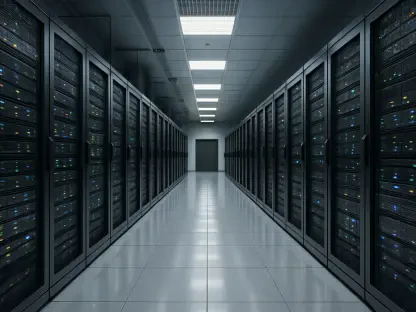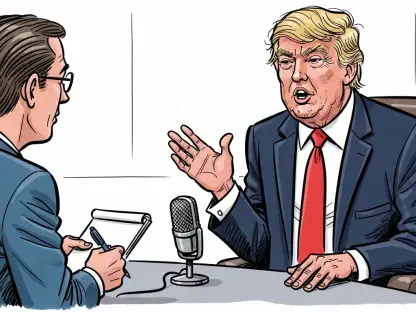As the effects of tariffs introduced by the Trump administration continue to ripple through the defense sector, major contractors are preparing for potential financial ramifications. Key industry leaders like RTX Corp., Boeing, and Lockheed Martin are navigating these economic challenges with varied approaches. The policies aim to drive manufacturing back to the United States, but the tariffs on essential materials have their own set of implications for defense firms. These companies face distinct levels of anticipation and have crafted specific strategies to address the complex landscape. This article explores the diverse perceptions and preparedness initiatives of these defense giants as they brace for the ongoing impact.
The Impact of Tariffs on Defense Firms
Diverse Anticipations
The introduction of tariffs has engineered a multifaceted landscape for major defense contractors. RTX Corp., previously known as Raytheon, is envisaging substantial financial strain, with possible losses approaching $850 million. This projection considers the collective impact of tariffs from Canada, Mexico, and particularly China, in addition to a general 10% global tariff on essential materials like steel and aluminum. RTX’s derivatives, Collins and Pratt & Whitney, bear a significant portion of this burden, each facing over $400 million in anticipated costs. On the other hand, the Raytheon division foresees negligible impact, showcasing a varied internal response within RTX Corp.
Contrasting RTX’s cautious outlook, Boeing and Lockheed Martin present a more robust perspective regarding their ability to mitigate tariff impacts. Boeing, fortified by a primarily U.S.-based supply chain, remains focused on maintaining manageable cost levels, while Lockheed Martin’s strategic foresight suggests avenues to completely bypass the tariffs. These contrasting anticipations underscore the varied resilience among key players, with some firms exhibiting stronger defenses against potential financial repercussions due to their strategic adaptability.
Tariffs as Economic Leverage
The tariff policies are designed as strategic instruments of economic leverage, encouraging the relocation of manufacturing sectors back to American soil. By targeting critical materials, these tariffs have created considerable strains on cost structures and strategic plans for defense firms. RTX Corp.’s substantial financial projections emphasize the magnitude of impact on companies heavily reliant on steel and aluminum imports. However, organizations like Lockheed Martin demonstrate a calculated leverage by limiting reliance on Chinese materials, thanks to longstanding contractual terms that avoid such sources.
This strategic leverage extends beyond direct supply chain considerations. Lockheed Martin and Boeing have adopted proactive measures by advocating for the development of domestic raw material sources. Initiatives focused on rare earth elements, for instance, aim to stabilize the supply dynamics and minimize external vulnerabilities. This approach reveals a dual strategy of direct impact mitigation and fostering long-term industry-wide resilience. By augmenting production capabilities domestically, these companies contribute to a broader industrial shift compatible with the tariffs’ overarching goals.
Strategies to Mitigate Tariff Effects
RTX Corp.’s Mitigation Plans
RTX Corp. has devised an array of strategies to navigate the challenges presented by the current tariff landscape. Exploring free trade zones offers one potential pathway to alleviate financial pressures, while seeking duty drawback refunds could reimburse part of the costs incurred due to tariff impositions. Additionally, RTX has concentrated efforts on diversifying suppliers and shifting assembly operations to less tariff-affected regions. This diversification aims to shield the firm from vulnerabilities associated with any single geographic or economic zone.
Despite these efforts, RTX faces inherent challenges as it transitions from a historically duty-free market to navigating a more complex financial and logistical environment. The strategic diversification of suppliers and assembly sites comes with its own set of operational complexities and risks. Nonetheless, by strategically pursuing these mitigative avenues, RTX attempts to align its operational models with the evolving economic landscape, aiming to strike a balance between protection against tariffs and maintaining competitive market positioning.
Tactical Approaches by Lockheed Martin and Boeing
Lockheed Martin and Boeing, both armed with their unique strategies, continue to tackle tariff-related pressures with confidence. Lockheed Martin underscores its strength by executing meticulous early performance strategies and optimizing supply chain operations to bypass tariff impacts. CEO Jim Taiclet’s vision encapsulates the firm’s capability to absorb disruptions without compromising delivery and financial performance. Key to their strategy is the strategic procurement of non-Chinese materials, effectively minimizing the adverse effects of Chinese tariffs.
Boeing, by contrast, remains more insulated due to its extensive U.S.-based supply chain. This foundational advantage provides a buffer against foreign tariffs, allowing the firm to maintain manageable cost augmentations. While acknowledging potential supply chain price increases, CEO Kelly Ortberg exhibits a level of assurance that these hikes remain within the firm’s threshold for financial stability. Boeing’s considerable experience in managing global supply chain dynamics equips it with the expertise to navigate these tariff challenges skillfully, ensuring continuity in operations and production outputs with minimal disruption.
Unique Challenges and Responses
The Role of Supply Chain Strategies
The supply chain strategy plays a critical role in mitigating tariff impacts, and both Lockheed Martin and Boeing have exhibited diversified approaches. Realizing the importance of securing non-Chinese materials, these firms are using their existing stockpiles effectively while emphasizing securing alternate suppliers. This forward-view strategy positions them advantageously to stabilize supply channels amidst an uncertain economic climate. The fortification of inventories ensures they remain supplied without interruption in their operations, maintaining their commitments and project timelines.
Additionally, these companies have explored or expanded collaborations with government stakeholders to support initiatives aimed at strengthening domestic supply sources. With tariffs placing a premium on imported raw materials, nurturing local production capabilities becomes vital for long-term stability. By supporting governmental programs and advocating for policy shifts that promote domestic raw material development, defense firms not only safeguard their supply chain integrity but also contribute towards building a broad-based defense manufacturing ecosystem.
Specific Industry Concerns
The aviation sector, in particular, faces unique challenges amplified by tariff-related disruptions. Boeing’s commercial aircraft division, under scrutiny due to China’s potential resistance to aircraft deliveries, adds a layer of complexity to its operational strategies. The company remains vigilant in maintaining substantial cash reserves and stable production levels to counteract potential destabilizations arising from these geopolitical tensions. Recognizing the fluidity of this scenario, Boeing continues engagement with policymakers to position aircraft exports as a pillar of the U.S. trade surplus, vital for sustaining economic relationships.
Simultaneously, these dynamics reflect broader industry concerns about the geopolitics intertwined with trade policies. With significant segments of the commercial aviation market linked to international relations, defense firms must navigate complex terrains balancing diplomatic engagement and economic strategy. As the aviation sector remains a pivotal component of global trade negotiations, companies like Boeing are keen to ensure their positioning within major market frameworks stays favorable, guaranteeing competitiveness alongside domestic economic benefits.
Adaptation and Resilience
Cautious vs. Confident Outlooks
The variance in responses to the tariff challenges highlights the differing levels of optimism among defense firms. RTX Corp. maintains a cautious stance, aware of the substantive financial stress induced by the continuing tariffs. Proactively mapping mitigation strategies like supplier diversification and leveraging free trade opportunities exemplifies prudence in addressing potential impacts. This preparedness forms a core aspect of RTX’s outlook as it navigates the complexities of a transformed trading environment, prioritizing resilience against unforeseen economic shocks.
Conversely, both Lockheed Martin and Boeing project a more confident outlook, relying on their diversified resources and preemptive strategies to guard against abrupt supply chain disruptions. Backed by supportive governmental policies in raw material development, these firms channel experiences garnered over decades to remain unfazed in the face of tariff-related hindrances. Their approaches underscore a combination of preventative measures and a robust operational framework capable of sustaining adverse economic conditions.
A Unified Industry Front
The introduction of tariffs by the Trump administration is sending ripples through the defense sector, prompting top contractors to brace for potential financial consequences. Noteworthy industry players such as RTX Corp., Boeing, and Lockheed Martin are employing different strategies to manage these economic hurdles. The policies are specifically aimed at incentivizing manufacturing within U.S. borders, yet the tariffs imposed on critical materials pose their own challenges for these defense firms. Facing varying levels of anticipation, these companies have crafted tailored strategies to confront the intricate economic landscape. This article delves into the differing perceptions and preparedness plans of these defense behemoths as they gear up for the continued implications of these policies. Their approaches illustrate not only readiness but also a proactive stance to navigate and mitigate any adverse effects, ensuring they remain competitive in a shifting market driven by domestic policy changes.









